|
Agility Course
YES! Goose Agility, Chicken Agility, Duck Agility, Parrot Agility, it can be done and is a lot of fun, but must be done correctly. Don't think about your bird doing the agility course quickly, but how cute the bird is manipulating the course. It is not about speed with birds.
The first thing you need is the proper agility equipment for the type of bird you own. Chickens have more balance then a goose. Ducks are lighter weight and smaller then geese. There are things a parrot can do that a goose can not. Think, think think and know your bird. Keep safety first and above all. Parrots can walk a high wire, geese, no. A goose will need a fat, wide based, low to the ground Balance Beam. If you keep it safe and fun for your bird your bird will look forward to spending the time with you on the equipment.
Part of the fun of making your equipment is decorating it. If you look at Dog Agility Equipment you will find that the pieces are decorated with dogs and or paw prints. How cute to make your course with birds and bird foot prints. Use a paint that will last and wait for it to dry and dry well before adding your bird to the mix.
Remember that without a diaper your bird is a bird and will make a mess on the equipment. You will need to clean that mess after each agility training section.
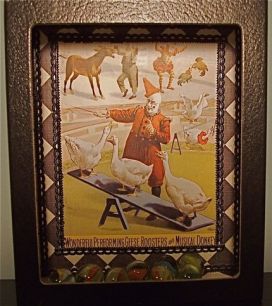
Is this a new concept? My goodness NO! People have been teaching birds tricks and tasks and agility, well, probably as long as people have kept birds as pets.
You must think and keep it safe. You must build your equipment so that your bird can manipulate it safely and correctly. You must work with your bird so that it understands what you are asking it to do...bring treats.
ALL TYPES OF SPECIES ARE ENJOYING AGILITY THESE DAYS!
A Few Of Our Own Animals Enjoying An Agility Course Some people would think I am kidding about birds enjoying an Agility Course. But I am not. Deron and I personally have taught all sorts of animals to Agility and had a lot of fun doing it. Below are a few photos of our own animals. If you want to see more of our animals photos just click on our sister sites listed at the right. In fact, Animal Agility is kind of "our thing". It really is fun and really builds a bond with your pet. We have a few videos at YouTube you can see from the our websites, including Fish Agility with our Betta Fish.
Photos are of (dog, goat, rat, gerbil, hamster, rabbit, mouse and guinea pig)
 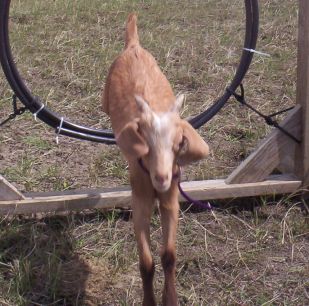 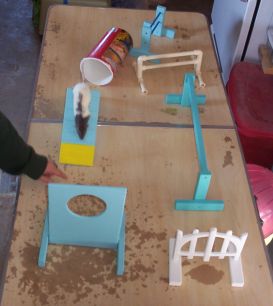 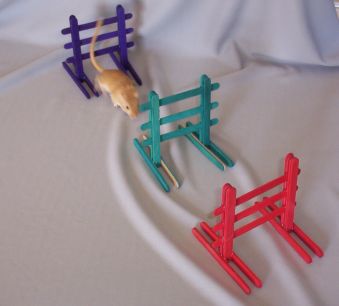 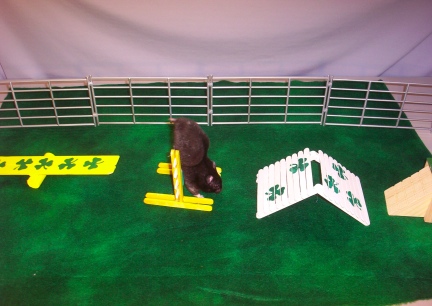 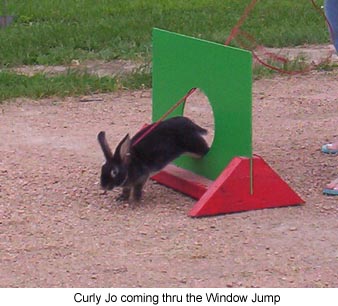 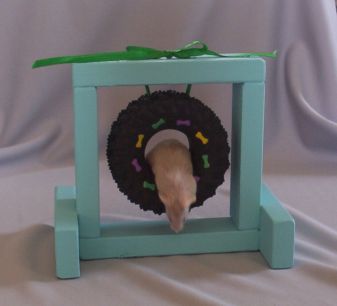 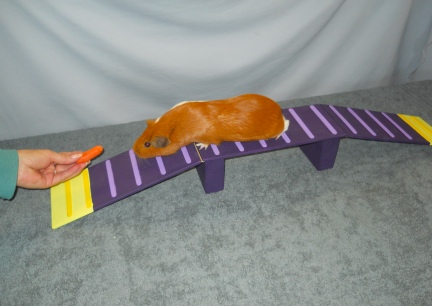
AND YES, THAT IS OUR CHICKEN TOO
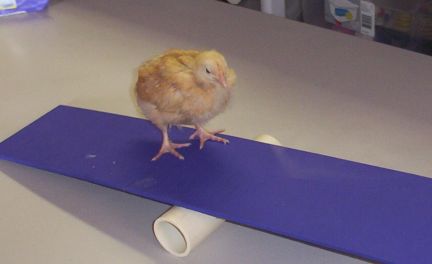
IDEAS FOR AGILITY EQUIPMENT FOR BIRDS
These are just a few ideas. You are only stopped by your own lack of imagination. Pick up a book or look on line at other animals, dogs would be your best bet, agility equipment and let your imagination take over, but rope it in for the safety of your bird. Seriously, keep all Agility Pieces low and stable for your bird. Make it safe. Have fun, and let the bird have fun too.
There are many types of Agility Jumps. The one you will start with for your bird will be the height and width you need for the size of the bird, with very low bars, if not bars on the ground, and stable enough so that if the bird lands on it to perch the jump will hold it's weight. For most birds just use a piece of a 2" x 6" board cut to about 3' length, standing with props at each end on each side to hold the jump upright and sable.
Start slow and easy. Some birds will get this the first time you ask, some will be afraid of the equipment. With the bar(s) very low on the jump, with you on one side and the bird on the other, call you bird over the jump with your hand or finger pointing down, if not touching the ground so that the bird knows you want it on the ground, not in the air.
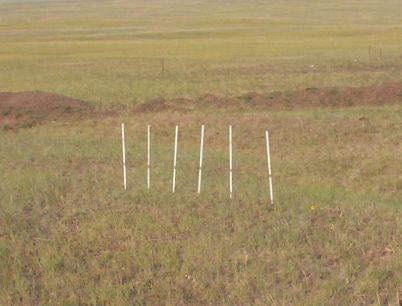
Weave Polls can be something as simple as Wooden Dowels sharpened and stuck into the ground. They need to be far enough apart so that the bird can walk easily between them. For a chicken approx. 2' apart, for a goose 3' apart.
As you walk with your bird, you will stay on one side of the Weave Polls and use your hand to "guide" the bird around the polls, going first to the left then to the right, then to the left.... be patient. The bird may do really well at first then try to skip a weave. If you bird is weary of the polls, try cutting them poles shorter so that the bird can see the top of the poles as it walks through them.

A Teeter Totter is a piece of board that pivots on a totter that can be a small log or the like. A Teeter Totter is a lower piece of equipment than the Sea Saw and is probably all one should use for most birds. You can use a 6' long 2" x 4" board screwed to a small log that is consistent in size so that it is very even from one side to the other, you want the teeter to be smooth and even when it pivots.
This is not a real easy piece of equipment to teach and should not be taught until your bird is doing well on other pieces such as the Dog Walk and Balance Beam. Your bird should trust you and the equipment before training this piece.
For some birds, such as geese, your Dog Walk might just be a 2" x 6" x 4' laid on the ground for the bird to walk along. For a chicken you might use a 2" x 4" x 8' raised on legs 3' high for them to walk along. You might add a small piece of wood down each side as a lip for the bird's feet to feel and stay between, or sides or railing on each side to keep the bird from walking off the side. The idea of this piece is for the animal to walk along the plank from one end to the other without leaving it. Again, do not hurry birds, it is not about speed as it is with dogs and other animals. It is better for this piece to be lower to the ground and safe for the bird.
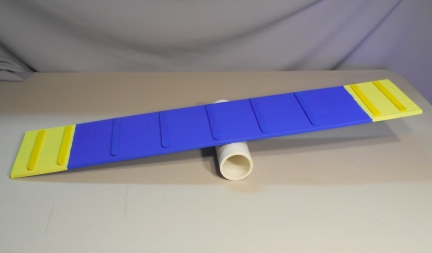
Yes. Geese, Ducks and Chickens can enjoy a Sea Saw if the Sea Saw is made low and wide without a high pivot. Your top board should be at least 9" side, and no longer then 4' long. Like the Dog Walk you could add to the sides of this piece to make it safer for the bird to stay on as it walks along the board. The pivot point could be made with a small log or a 3" piece of PVC pipe. The pivot should be placed just off center on the bottom side. This piece will take a lot of patients on the person's part to teach. You must work with the bird to teach it to come over the Sea Saw, Teeter Totter really. You must use you own foot to hold the board as it pivots (when the bird is just learning) so that it pivots slow and easy. By pivoting slow and easy, it will not scare the bird.
Your best bet for an Open Tunnel for your birds are plastic barrels with both ends cut out. You will certainly not want anything too long or too dark or your bird will fear it. You can use a 30 gallon plastic barrel (car wash places usually will give them to you) for most types of birds. White in color will be the easiest for the bird to get used to.
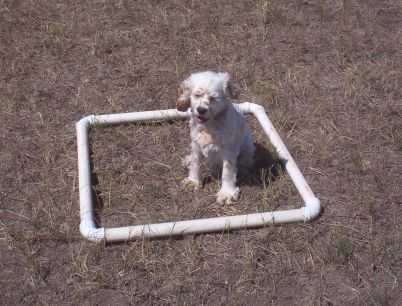
The idea here is for the bird to sit on the box, or platform, or just a square of PVC piping when and for how long you tell them to. With dogs it is like 5 seconds. With birds you can decide, again, birds should not be in a hurry on the agility course. You might also just use a piece of wood that is flat approx. 18" x 18" painted real cute. Or, as they have in Dog Agility, a Pause Square. A Pause Square is a square made out of PVC pipe with corners. All the bird would do is step into the square. (yes that is my dog and yes we did make that agility pause square ourselves)
When most people think Balance Beam they think tall and thin. Well for animals and some children that is just not always true. A Balance Beam for a chicken or duck or goose needs to be low, no higher then 10", and wide, approx 12" wide. It also should not be too long for the animal either. The length should be no longer then 4'. Each end of the Bird Balance Beam should have a ramp so that the birds can walk right up and right down safely. You might add sides or some sort of side indicator for the bird to feel with it's feet as it walks along the board.
A Pedestal is not a standard piece of agility equipment, but would be a good or cute place for your bird to finish the course with a "ta da". Birds can easily be taught to "curtsy" on the pedestal and it would add a lot to your little show. You want your Pedestal to be low enough for the bird to get up on by itself, but high enough to look like a Pedestal. You can paint it and make it fancy, but make sure the top is of a surface that the bird will not slip on.
STARTING YOUR BIRD ON THE EQUIPMENT
When you first start your bird, or any animal, on an Agility Course, you start with one piece of the equipment. Start with something easy for the bird to learn. A low Jump is usually a very good choice. Start the bird on that piece and continue until the bird fully understands that it is to go over the Jump, not around it, not under it, but over it. You might even walk the bird and go over the Jump before the bird to teach it the Jump. When you bird is doing the Jump well, add a second piece of equipment behind the Jump. In other words, backchaining, or starting your bird on a new piece then on to the familiar piece. Go slow, encourage, never yell, shove, push or force your bird through the Agility Course. Once the bird learns the two pieces of equipment, add the third so that the bird has to manover it first before the two it is familiar with. If you keep this fun, make sure you bird understands what you are asking, your might just be very surprised how fast your bird or other animals will learn and enjoy an Agility Course.
GET IT ON FILM!
Once your bird learns or as your bird is learning the Agility Course, take some photos, make a video. Not only will it prove to others that you really did train your bird on an Agility Course, but later in life you will want to look back on that long gone pet and remember all the fun you had making the equipment and training and sharing a fun time with your pet.
COMPETITION?
Well, like any type of Animal Agility it can catch on and others will want to compete. Did you know that ALL Animal Agility started with Horses? That is why some folks still call any of the Agility Pieces Jumps. They also might call your course or event Show Jumping. Once you get going and talking about it to your bird friends the sport will catch on. You might even do demonstrations at Bird Shows, Pet Shops and other events. The more you promote the sport the faster it will catch on.
The contents of this page for Agility Course is still under construction. Please check back later!
| 



 In the high plains of South Dakota, USA
In the high plains of South Dakota, USA In the high plains of South Dakota, USA
In the high plains of South Dakota, USA